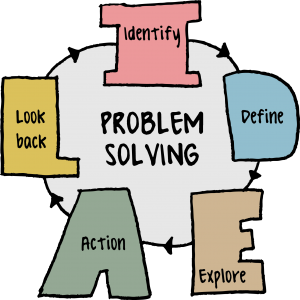Very few things in life come with an instruction manual, and when they do, it is because that object has a particular purpose. What happens when an aspect of our life is breaking down, not fitting together quite right or missing a scew? What do we do to fix these problems? My hope is that we have learned the skills and been given the tools to find a solution. The types of problems I am referring to are the ones that require critical and creative thinking, Creativity in the Classroom: Schools of Curious Delight gives the following example –
“At 19, Jean was homeles and a senior in high school. One cold evening he thought
that a warm space inside the school would be a more appealing sleeping place than
any he could see. Getting into the building was no problem, but onces he was inside
a motion detector would make him immediately detectable to the guard on the floor
below. Juan entered a storage room and carefully dislodged a bile of baseball bats.
In the ensuing commotion, he located a comfortable sleeping place. The guard
attributed the motion detector’s outburtst to the falling bats, and Juan slept until
morning.” (Starko, 2014).
 Juan was in a difficult situation and used problem solving skills to solve his problem. Creativity
Juan was in a difficult situation and used problem solving skills to solve his problem. Creativity
does not only refer to art, music, dance. Being able to problem solve using creativity is an important life skill.
Teaching our students how to problem solve in a creative way is a lesson they will keep with them forever. Problem solving builds resiliance and allows us to solve a variety of problems we are faced with on a daily basis.
Reference:
Starko, A. J. (2014). Creativity in the Classroom: Schools of Curious Delight (5th ed.). New York, NY: Routledge. Retrieved February 10, 2016, from https://books.google.ca/books?hl=en&lr=&id=WVciAQAAQBAJ&oi=fnd&pg=PP1&dq=how to incorporate creativity in the classroom&ots=PetEmz3qu7&sig=ECVxZvtigXL-BrLruHFkbnakRm8#v=onepage&q=how to incorporate creativity in the classroom&f=false.



 As teachers, the language we use with our students can be very impactful in their education. Using words with negative connotations can have an impact that students take to heart. What about when we use words that are perhaps, overly positive? Might the use of these words set an expectation to students? When we use words to commend good work, I think it is important to promote the effort – “well done!” “good work” “you are getting much better at…!”. These are things that will motivate our students to achieve, it will not cause them to doubt and it will not cause them to plateau or create anxieties of unrealistic expectations. When we see improvement in our students efforts, we must commend their work, it is important that we do. But is it not just as important that we promote growth as well?
As teachers, the language we use with our students can be very impactful in their education. Using words with negative connotations can have an impact that students take to heart. What about when we use words that are perhaps, overly positive? Might the use of these words set an expectation to students? When we use words to commend good work, I think it is important to promote the effort – “well done!” “good work” “you are getting much better at…!”. These are things that will motivate our students to achieve, it will not cause them to doubt and it will not cause them to plateau or create anxieties of unrealistic expectations. When we see improvement in our students efforts, we must commend their work, it is important that we do. But is it not just as important that we promote growth as well?